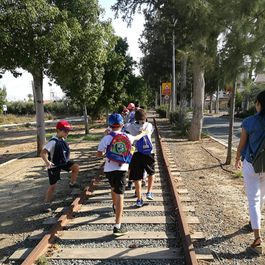

On the 17 of October, within our Erasmus+ program, children of the school had the chance to take a guided tour around the old Kaimakli area. They visited the local church, the Kaimakli renovated square, and old coffee shops of the area. They admired the renovated houses and they visited the inside of one of these houses. They walked the old narrow roads of Kaimakli with the early 20th century doors. They also walked on the old train rails explaining why they are there, and why they are no longer in use. The saw an ice-cream factory.
They also walked near the UN “Green zone” which separates the Cyprus Democracy from the Turkish occupied area of Nicosia.
After the tour they participated in a hand-weaving workshop, after witnessing the traditional way of weaving with the loom.
You can see pictures of their work, and also of their tour on our website.
More children will have the same experience on the 31st of October. (They can’ t wait).
On the 17th of October the children participated in a weaving workshop. The firstly saw work of the artist and also traditional woven items. They saw how the loop would work and they talked to the artist. Then they had the chance to weave themselves.

It all started with the reading of the fairy tale "Through their eyes" by the writer Konstantopoulou Fotini, a police officer who through this fairytale recorded the stories and dreams for the future of 12 refugee children. Reading each story caused absolute silence in the classroom because each of them revealed tragic and incredible stories of children. At the same time, it caused admiration towards these children because they managed to survive in a disastrous environment, that of war, uprooting and persecution. Then, a video was projected about one of Picasso's greatest works, Guernica. A worK that describes the inhumanity, brutality and despair of war. Then, the students were asked to cut everything they drew on the black cardboard, then stick the piece of it in the middle of white, larger cardboard and take the pieces they had and glue them to the white cardboard in such a way that it looks as if they were reflected. In the end, the students were asked to record their interpretation of each piece of their plan.
The works of the students present their emotional identification with the mental state of a refugee and their understanding of the behaviour and motivations for everything that this person does. This is called empathy.
This work was done by the students of the sixth grade of the Third Primary School of Kaimakli (KB) under the guidance of their teacher, Mrs Dora Tzialli in the context of the Art course and for the purpose of Erasmus + "Cultural heritage: An inclusive path for participation and exchange in Europe

THE BOAT THAT DID NOT SINK
THE COUNTRY WITH THE WEIRD PEOPLE
His life was getting more difficult every day. He was kicked out of his job because he was different. He was kicked out of the shops because he was different. In public transport, they did not accept him because he was different. His friends stopped hanging out with him because they were ashamed that he was different. And he was asking himself: now they noticed that I am different? Do I have to be myself in them? (From the presentation on the back cover of the book)
The children of the fourth grade of 3rd Kaimakli Primary School after reading and exploring the ideas in the book they did the above activities.
-
Analyzed the feelings of the hero
-
They referred to the concept of diversity and racism as an individual and social issue
-
The concept of joy we give with the acceptance of people with different characteristics and talents than our own
.png)
.png)
.png)
.png)
.png)
Were there countries that benefited from World War II?
With this central question in mind, we, the children of ST'2, interrogated various and different sources, such as photographs, objects, songs, poems, articles in newspapers, paintings, memoirs and narrations of concentration camp survivors and war veterans that we identified in her book History, Language and the Internet. We researched, discussed and collected information, present them and, we have reached conclusions.
We gave particular importance to the painting Papal Picasso "Guernica", exploring when and why it was painted by Picasso, what it depicts and what it symbolizes. We discussed the quote that says how when the Germans entered Paris against the Second World War, in their attempt to find artistic treasures and confiscate them.
A German officer showed in a photograph the painting "Guernica" to Picasso himself who had been brought in asking him, "Did you make this painting?" And he courageously replied, "Not, You did it!"
We noticed that Picasso avoided painting planes, bombs or rubble. The dominant forms of the work are a bull and a wounded horse with dismembered bodies and four women screaming holding dead babies. According to Picasso. "The removal of colour and relief is a break in the relationship of man with the world: when it is interrupted, there is no longer nature of life." After the discussion and the analysis of the symbols that Picasso used in his work, we selected pieces from the painting and made
our own Guernica adding, each child new touches.
Our conclusion was that no country benefited from the war. The losses were horrific with millions dead, wounded, maimed, displaced and severely damaged human creations and the natural
environment.

















